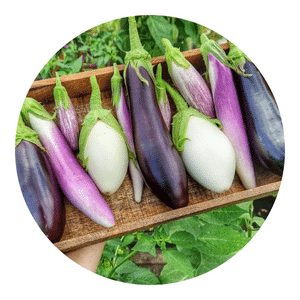Are Japanese Sweet Potatoes Similar to American Yams?
No, Japanese sweet potatoes are not similar to American yams.
Although both are root vegetables, they belong to different botanical families and have distinct characteristics.
Japanese sweet potatoes, also known as Satsuma-imo or Japanese yams, have a reddish-brown skin and a pale yellow to white flesh. They have a slightly sweet flavor and a dry, starchy texture when cooked.
Japanese sweet potatoes are commonly used in Japanese cuisine and are popular for roasting, steaming, or making traditional dishes like sweet potato tempura or imo-ni.
American yams, on the other hand, are a different type of tuber known as Dioscorea. They are typically larger and have a rough, dark brown skin.
Yams have a moist and starchy flesh that can vary in color, ranging from white to yellow to purple. They have a sweeter taste compared to Japanese sweet potatoes and are often used in African, Caribbean, and Latin American cuisines.
While the terms “yam” and “sweet potato” are sometimes used interchangeably in the United States, true yams are not commonly found in American grocery stores.
Most of the sweet potatoes available in the United States are actually variations of the sweet potato species, including the Japanese sweet potatoes.

Table of Contents
Botanical Classification
Japanese sweet potatoes and American yams may be commonly mistaken for one another due to their similar appearance and taste.
However, from a botanical standpoint, they are not closely related.
Japanese sweet potatoes belong to the Ipomoea batatas species, which is in the morning glory family. These sweet potatoes have reddish-purple skin and white or yellow flesh, with a slightly sweeter flavor compared to regular sweet potatoes.
On the other hand, American yams belong to the Dioscorea genus, which is entirely different from Ipomoea batatas.
Yams are native to Africa and Asia and have been cultivated for centuries. They have rough, dark brown skin and orange or purple flesh with a drier texture than Japanese sweet potatoes. The taste of yams is often described as starchy or earthy.
Despite their differences in botanical classification, both Japanese sweet potatoes and American yams are nutritious root vegetables that can be enjoyed in various culinary preparations.
Understanding their distinctions can help individuals make informed choices when selecting ingredients for specific recipes or dietary preferences.
Appearance
In terms of appearance, Japanese sweet potatoes and American yams have distinct differences.
Japanese sweet potatoes are easily recognizable by their reddish-brown skin, which is often smooth and shiny.
The flesh of these sweet potatoes can range from pale yellow to white in color.
On the other hand, American yams have a rough and dark brown skin that is sometimes covered in small bumps or indentations.
The flesh of American yams can vary greatly, with some varieties being white, while others are yellow or even purple.
The appearance of these two root vegetables also plays a role in their culinary uses.
The vibrant orange hue of Japanese sweet potatoes makes them visually appealing when used in dishes like roasted vegetables or mashed potatoes. Their creamy white flesh allows for a soft texture when cooked, making them perfect for baking or roasting as well.
On the other hand, the darker skin of American yams provides a contrast to their colorful flesh when sliced or diced for cooking purposes. This makes them an excellent choice for stews, soups, or even as an accompaniment to grilled meats.
Overall, while both Japanese sweet potatoes and American yams belong to the same botanical family and share some similarities in taste and texture, they differ significantly in appearance.
The reddish-brown skin and pale yellow to white flesh of Japanese sweet potatoes create an inviting aesthetic appeal for various culinary applications.
Flavor and Texture
When it comes to flavor and texture, Japanese sweet potatoes and American yams have distinct characteristics that set them apart.
Japanese sweet potatoes are known for their slightly sweet flavor, which is not overpowering but still provides a pleasant taste.
On the other hand, American yams have a noticeably sweeter taste that can be more intense than that of Japanese sweet potatoes. This difference in sweetness adds an interesting contrast when comparing the two varieties.
In terms of texture, Japanese sweet potatoes tend to have a dry and starchy consistency when cooked. This makes them perfect for baking or roasting, as they become fluffy on the inside while retaining their shape and slight crispness on the outside.
Meanwhile, American yams have a moist and starchy texture that lends itself well to mashing or purees. Their smooth and creamy consistency makes them ideal for dishes like mashed yams or pies.
Although both Japanese sweet potatoes and American yams fall under the same family of root vegetables, their flavor profiles and textures differ significantly. These distinctions make each variety unique in its own right and offer various culinary possibilities depending on personal preferences or desired recipes.
Whether you enjoy the drier fluffiness of Japanese sweet potatoes or prefer the creamier moisture of American yams, there’s no denying that both provide delicious options for diverse cooking experiences.
In orchards far and wide, a tale unfolds, Of Japanese sweets and yams so bold. Their colors vibrant, hues of earth's own blend, A journey from the East to West, I commend. With roots entwined in soil where legends grow, Kinship is found between their hearty souls. Though distinct in name, they share sweetness pure, Japanese sweet potatoes and yams secure.
Chappy The Gardener
Culinary Uses
In Japanese cuisine, sweet potatoes are a versatile ingredient that is commonly used in various culinary preparations. They are often roasted, steamed, or boiled and used in dishes like tempura or imo-ni, which is a traditional potato stew.
The sweet and earthy flavor of Japanese sweet potatoes makes them a popular choice for both savory and sweet dishes in Japan. They can be enjoyed as a side dish, incorporated into soups and stews, or even used as an ingredient in desserts.
On the other hand, American yams have gained popularity not only in African cuisine but also in Caribbean cooking. These tubers are known for their vibrant orange flesh and slightly sweeter taste compared to regular potatoes.
In African cuisine, yams are often mashed or served as a side dish alongside meat or vegetables.
In Caribbean cooking, they are frequently used in hearty stews and curries like the popular Jamaican dish called ackee and saltfish.
The versatility of American yams allows them to be utilized in various culinary applications across different cultures.
Overall, while there may be some similarities between Japanese sweet potatoes and American yams due to their shared characteristics of being root vegetables with a sweet taste profile, they differ significantly when it comes to their usage in specific cuisines such as Japanese versus African or Caribbean cooking styles.
Understanding these differences can help individuals explore new flavors and incorporate these ingredients into their own culinary creations.
Availability
Japanese sweet potatoes and American yams may often be confused due to their similar appearance, but they have distinct differences in taste, texture, and availability.
While Japanese sweet potatoes are becoming increasingly popular and can be easily found in markets and grocery stores, American yams are less common. In fact, finding true yams may require a trip to specialty food stores or Asian markets.
The availability of Japanese sweet potatoes is largely attributed to their growing popularity among consumers who appreciate their unique flavor and versatility in cooking. They have a drier texture compared to American yams, making them perfect for baking or roasting.
On the other hand, American yams are more moist and starchy in texture when cooked, which makes them ideal for mashing or using in soups.
Due to the limited availability of American yams, many people tend to use sweet potatoes as a substitute when following recipes that call for yams.
However, it’s important to note that despite their similarities in appearance and how they are referred to colloquially as yams, these two varieties belong to different botanical families.
So next time you’re looking for a specific type of potato for your recipe, keep in mind the availability of Japanese sweet potatoes compared to true American yams.
Geographic Origin
Japanese sweet potatoes and American yams, although both root vegetables, have distinct differences in their geographic origins.
Japanese sweet potatoes are native to East Asia, with Japan being their primary place of cultivation for centuries. They have become an integral part of Japanese cuisine and are loved for their unique flavor and texture.
On the other hand, American yams are primarily grown in tropical and subtropical regions, such as Central and South America, the Caribbean, Africa, and Southeast Asia.
The geographical origin of these two tubers has resulted in variations in their appearance, taste, and culinary uses.
Japanese sweet potatoes typically have reddish or purple skin with creamy white flesh that becomes soft and moist when cooked. Their flavor is mildly sweet with hints of chestnut or honey.
In contrast, American yams have rough brown or black skin with a starchy orange or yellow flesh that remains firm even after cooking. They possess a sweeter taste compared to regular potatoes but lack the distinctive sweetness found in Japanese sweet potatoes.
Despite these differences in geographic origin and characteristics, it is important to note that the terms yam and sweet potato are often used interchangeably in the United States due to historical reasons.
The bright orange-fleshed varieties referred to as yams by Americans are technically just different types of sweet potatoes. This confusion can lead to misunderstandings about the true nature of these two root vegetables from different parts of the world.
Nutritional Profile
They both contain significant amounts of vitamin A, which is essential for maintaining healthy vision and a strong immune system.
Additionally, Japanese sweet potatoes and American yams are rich in vitamin C, an antioxidant that helps protect the body against damage caused by free radicals.
Both varieties also provide a good amount of potassium, which plays a crucial role in regulating blood pressure and heart function.
Furthermore, these root vegetables are high in dietary fiber, promoting healthy digestion and preventing constipation.
The fiber content also helps to regulate blood sugar levels after meals, making them suitable options for individuals with diabetes or those looking to manage their weight.
In terms of minerals, both Japanese sweet potatoes and American yams offer essential nutrients such as magnesium, iron, and calcium.
Overall, while there may be slight differences in nutritional content between Japanese sweet potatoes and American yams based on soil conditions and growing methods, they are both highly nutritious options that can be incorporated into a well-balanced diet.
In conclusion, while Japanese sweet potatoes and American yams are often confused due to their similar appearance, they have distinct differences in taste, texture, and nutritional content.
Japanese sweet potatoes are sweeter and have a creamier texture compared to the drier and starchier American yams.
Additionally, Japanese sweet potatoes are rich in vitamins A and C, whereas American yams contain more carbohydrates and dietary fiber.
Understanding these differences can help individuals make more informed decisions when it comes to their culinary choices or dietary needs.
So next time you come across these tubers at your local grocery store, remember to choose wisely based on your preferences or health requirements.
Click To Grow
Helps Us Grow – Share If You Like












